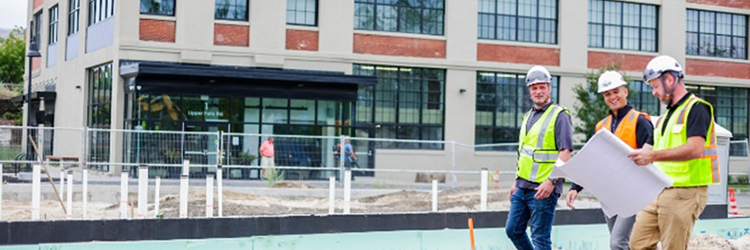Diversification: It is important to be nimble and change with the market - by Michael Cobb
 Michael Cobb, Cardente Real Estate
Michael Cobb, Cardente Real EstateFor many real estate investors, diversification is often not the norm. People like to invest in what they know. As Wall Street mogul Peter Lynch once said, “Know what you own, and know why you own it.” For an investor that has owned nothing but industrial properties, it may be a stretch to consider retail, office or even a residential conversion. Likewise, many investors are only comfortable buying in a specific geographic location. This can often present a challenge in maximizing returns, specifically if that region trades at a lower capitalization rate. The real estate market in Southern Maine has been highly successful over the last few quarters and vacancy rates are at record lows, however, we have seen certain trends in the market where owners, tenants, and investors are being rewarded for thinking “outside the box.”
One trend that has been prevalent in the Greater Portland area is the repurposing of older building stock. As new construction prices soar, it is often more affordable to restore and rehab old structures than it is to build new ones. For example, the cost for new construction of a warehouse building is $60 to $70 per s/f. Now add in land cost and it is upwards of $100 to $115 per s/f. Compare that number to the average sale price of an existing industrial building at $55 to $60 per s/f and add in restoration costs, it can still be more appealing for tenants or buyers to wait and find an existing building.
One of the larger scale projects matching this model is the restoration of Thompson’s Point in Portland. This 30-acre parcel was a longtime home to a rail yard frequented only by a growing homeless population and local graffiti artists. Thanks to the vision and commitment of local investors led by Chris Thompson, this area is now a crowd pleasing multi-use property boasting an outdoor concert venue, Bissell Brothers Brewing Company, Cellar Door Winery, and various other retailers.
Another great example is a building located at 272 Lancaster St. in Portland, soon to open as Fork Food Lab. This was an old brick building in what has long been considered a less appealing location of Portland. Once home to a boxing gym, the building had become forgotten storage space and showed signs of many years of deferred maintenance. Local entrepreneurs, Neil Spillane and Eric Holstein stripped the building back to its studs and invested in a “state-of-the-art” build-out to create a collaborative commercial kitchen which will serve as home to new and existing restaurateurs.
Portland’s East Bayside area is another example of historic buildings restored for modern day use. East Bayside was once home to the Peninsula’s industrial district and has changed drastically over the past ten years. The neighborhood has become home to many high-end craftsmen, a multitude of breweries, craft distilleries, coffee houses and fitness centers. In fact, it has become such a beacon for Portland’s flourishing craft beer market and other fermentation based businesses that the area has been locally coined “Yeast Bayside.”
Finding creative ways to repurpose existing real estate is not a trend that is limited to Greater Portland. Up the coast in Ellsworth, Jackson Laboratory purchased a former Lowe’s building with plans to create a facility for genetics research. The site is a 17-acre parcel improved by a 140,000 s/f building. The Ellsworth expansion is expected to cost upwards of $75 million. Lowe’s closed its doors after only two years in business as part of a nationwide decision to shutter underperforming locations. In Freeport, a stunning 8,200 s/f retail building is now home to a local credit union. The property had been vacant since it was built in 2006. It was originally part of an expansion strategy that came to a halt when the economy crashed. Several brokerage firms attempted to sell it over eight years; largely focusing on retail users. It sold in 2015 to Midcoast Federal Credit Union who opened a small retail branch only to convert the majority to office space and served as their regional headquarters.
No matter what region or market sector, it is important to keep diversification in mind. As the market changes, keep an open mind to adaptive “re-uses” and creative ideas to fill existing space. When searching for investment opportunities, keep in mind that Maine is a proven market that has survived since the 1600’s. There are strong stable communities in and outside of Greater Portland that offer capitalization rates well above the national average. When comparing returns to that of major metropolitan markets such as New York and Boston, investors should take notice. It is important to be nimble and willing to change with the market. With a slogan like, “The Way Life Should Be,” Maine is certainly worth a look.
Michael Cobb is a broker/partner with Cardente Real Estate, Portland, Me.
Reveler Development celebrates final phase of work at The Levee - new 51-unit apartment building in Biddeford


Maine multifamily outlook: Opportunities in Portland, Bangor, and Lewiston-Auburn - Blake Wright and Kristie Russell
The multifamily market in Maine’s major cities presents a diverse range of opportunities for investors. We looked at the potential benefits and unique characteristics of three major submarkets in the state: Portland, Bangor, and Lewiston-Auburn. The information below is based on research done in CoStar and county registries, and focuses on multifamily properties that have four or more units.

Interest rates and inflation - by Matthew Bacon
As we all know, interest rates have been changing drastically, with movement in both directions, depending on the type and term of financing. The Federal Open Market Committee has taken drastic action in efforts to curb abnormally high inflation, but it hasn’t controlled labor cost growth to the extent that was intended.

Residential is here to untie the office space doom loop - by Thomas House


 (1) (1).png)





.png)


.png)